Transportable Aircraft Maintenance Yard No. I
Assembly and commissioning in the UK
Personnel for Transportable Aircraft Maintenance Yard No. 1 (TAMY 1) began to arrive at Royal Naval Air Station Ludham from December 4th 1944; the unit began to assemble later in that month. At this time RNAS Ludham was pretty crowded, the personnel of MONAB III and the HQ personnel of MONAB II were due to depart on the 22nd, MONAB IV had begun assembly on November 15th and MONAB V was due to begin assembling on December 6th; it became clear that there would not be adequate room to house the considerably larger elements of a Transportable Aircraft Maintenance Yard..
Split formation: A decision was made to split the formation, in the same manner as had been done with MONAB II; the HQ component was to form at Ludham and the technical components at RNAE Risley, HMS GOSLING in Lancashire. Whilst at H.M.S. GOSLING the principal activities of TAMY I personnel were those of kitting up with battledress and tropical clothing, and the mustering and making good of personal tool kits. Embarkation leave was given to all hands, both at Ludham and Risley, during the formation period; this leave had to be balanced against the requirement for personnel from TAMY I to assist the Mobile Naval Airfield Organisation Headquarters with Station, Pay, Victualling, and Galley duties.
Being a self-contained Aircraft Maintenance Yard TAMY I did not comprise of the modular components of MONABs, but these could be added later after its installation at its base of operations in response to changing requirements in theatre.
TAMY I was commissioned as an independent command bearing the ships name H.M.S. NABSFORD, on February 1st 1945, Commander B.J.L. ROGERS-TILLSTONE in command.
Despatch overseas
The personnel & equipment of both TAMY I & MONAB V departed by road and rail for Gladstone docks, Liverpool, on February 16th for passage to Australia. The main party of TAMY I, (a total of 23 officers & 1,191 ratings), sailed for Australia on board the Troopship STIRLING CASTLE on February 18th, in company with personnel of MONAB V. A second, retard party, comprising of 8 Officers and 91 ratings sailed on March 10th on the Troopship EMPRESS of SCOTLAND, in company with the personnel of M.R. 1 (a component bound to join MONAB V at Jervis Bay, New South Wales). The first echelon of stores and equipment sailed from Liverpool on board the Sea Transport Vessel CLAN CHATTAN II on February 20th, with the second echelon sailing from Liverpool on board Sea Transport Vessel HORORATA on March 1st.t.
An advance party of TAMY I comprising of 4 officers and 28 technical ratings had been sent out from the UK on earlier transport, arriving in Brisbane at the beginning of February 1945. This party, together with 80 hands loaned from HMS GOLDEN HIND, the RN Barracks in Sydney and supplemented by the addition of No.1 S.M.P. (Special Maintenance party) were accommodated at Rocklea Camp in Brisbane, this camp was to be the main accommodation site for TAMY I. Known as the 'Corsair technical party' this advance party was under the control of HMS FURNEAUX, the local naval base, and was tasked with erecting 16 Corsair IV aircraft at Kerry Road, Archerfield; 12 of the aircraft were almost completed by the time the main body of TAMY I arrived on March 27th. This was an extremely slow rate of progress; however, the work was started without any equipment or stores, all of which had to be acquired or borrowed from the Department of Aircraft Production, the Royal Australian Air Force and other local sources. Work was farther hampered in early March when many of the ratings had to be taken off aircraft erection duties in order to prepare Rocklea Camp, in advance of the main party's arrival at the end of the month.
TAMY I inherited facilities formerly used by US forces in the Brisbane area, the US presence having been withdrawn after the liberation of the Philippines; the principle facilities left by the Americans were those at Kerry Road and Rocklea Camp. The men of the advance party enjoyed relative luxury in their accommodations at the beginning, the huts at Rocklea Camp having single beds and fitted wardrobes. These were soon to go; a programme of alteration was to carried out to convert hundreds of fitted wardrobes to enable two-tier beds to be installed. Other tasks which were attempted by this small party were the transporting and rigging of extra beds, bedding and other furniture, rigging up of offices, and the general cleaning of all quarters and provisioning ships stores.
Commissioned at RNAMY Archerfield, Brisbane
The STIRLING CASTLE arrived at Brisbane, on March 27th, after unloading the first echelon of TAMY I personnel, the ship then continued on to Sydney to off load MONAB V. The facilities at Archerfield airport were commissioned as HMS NABSFORD, Royal Naval Aircraft Maintenance Yard Archerfield on the same date. Rocklea Camp was the administration and accommodation base of TAMY 1, aircraft operations were conducted at Archerfield airport and Kerry Road.
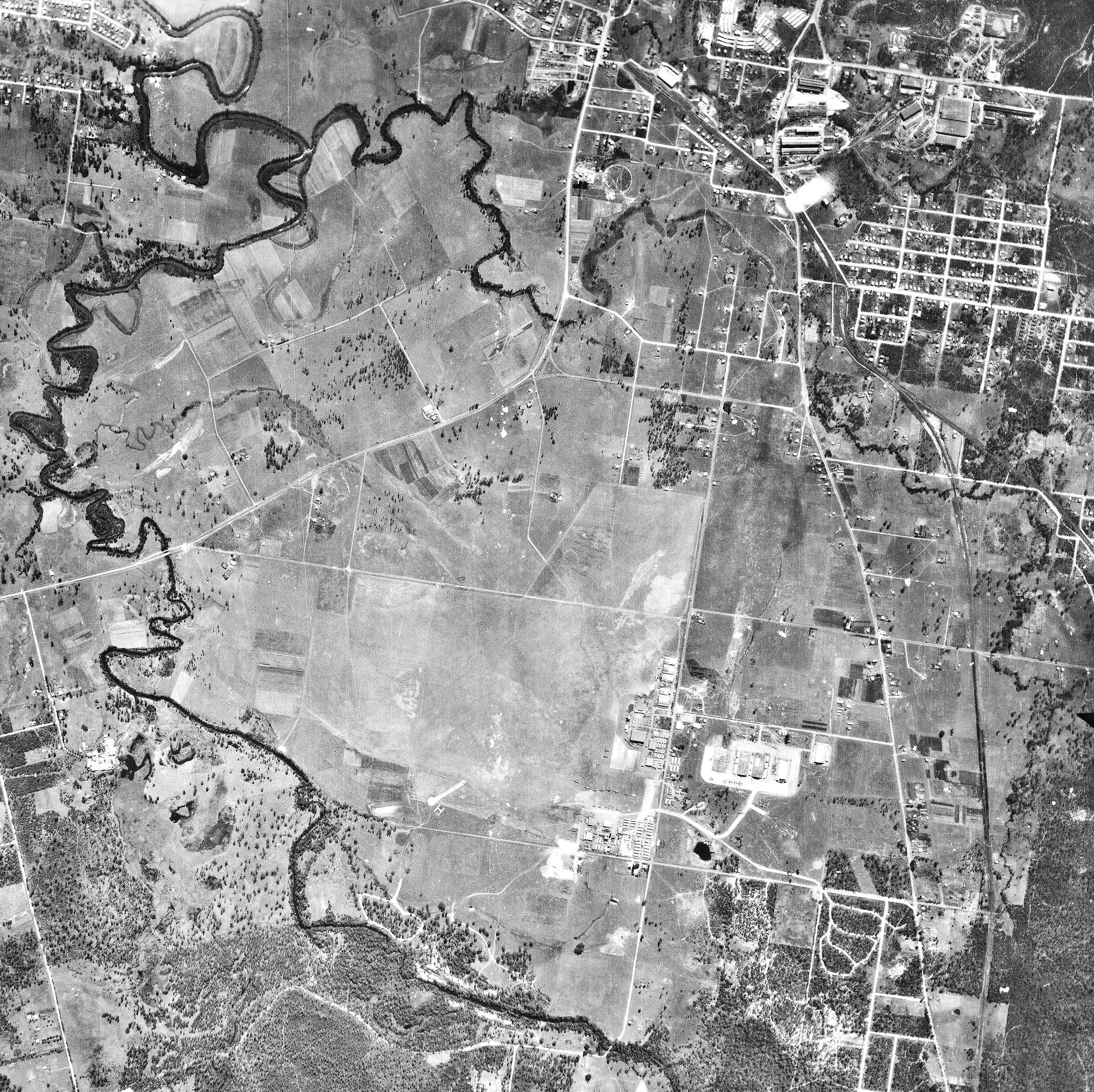
Archerfield aerodrome and surroundings viewed from 17,000 feet in April 1944. The Kerry road site with its large rectangular hardstanding is clearly visible, adjacent to the civilian hangars and control tower. RAAF Archerfield is in the bottom right corner of the airfield. The Seabee camp at Rocklea, later RN Camp Rocklea, is the ‘horseshoe’ shaped collection of buildings on the upper right edge of the picture, Rocklea Factory is adjacent, right.
The Air Yard was to be spread across several sites in the city, not all were close to the airfield:
| Sites occupied upon arrival |
| Accommodation at Rocklea Camp |
| Airfeld facilities at Archerfield airport |
| Erection, inspection & repair, air radio and air gunnery workshops at Kerry Road, Archerfield |
| Engine & ancillary workshops at Rocklea Factory |
| Sites acquired later in 1945 |
| Workshops for the reduction of airframes to spares and produce at Benedict Stone Works |
| Airframe parts and engine store at Runcorn |
One of the main problems facing TAMY I was transport; owing to the dispersed nature of the 'Yard' large numbers of personnel needed to be ferried to and from their accommodation to their places of work. Aircraft erection, airframe inspection and repair, air radio and a part of the air gunnery workshops were situated at Kerry Road, Archerfield airport, about 2 ½ miles from Rocklea Camp and 3 miles from Rocklea Factory. Later site acquisitions like Benedict Stone Works were 7 miles away across the city. A number of vehicles were loaned from the Department of Aircraft Production, including several 100 seat buses, without which the movement of several hundred ratings to and from Kerry Road twice a day would have been entirely impracticable. The allocated lorries, which were to be made available to TAMY I upon its arrival in Australia, did not arrive until several months later.
The unit's accommodation was to prove problematic for other reasons too; the entire ship's company was accommodated in Rocklea Camp, but the dining hall and galley were located half a mile away in Rocklea Factory, the site of the engine and ancillary workshops. Feeding the ship's company was further complicated by the fact that the main galley was approximately 100 yards from the dining hall, necessitating all cooked food being ferried across in hay boxes. Meal service was provided along cafeteria lines, employing 4 Chief and Petty Officers and 52 ratings to operate the dining hall and galley.
There was no Sick Bay in existence at any of the TAMY I premises; a building planed for March, was not to be constructed until late September. Meanwhile makeshift arrangements were made utilising several rooms in both the Rocklea Factory and at Kerry Road for examination and treatment of light cases. This resulted in the necessity of sending all cot cases to hospital. An attempt to provide a temporary Sick Berth at Rocklea Camp saw several beds set up in one of the huts, but the conveying of food from the distant galley limited numbers and when MONAB VII arrived in August the accommodation shortage saw the hut taken over for ordinary accommodation purposes again. No dental surgery existed, and all patients had to be sent to local service establishments to receive treatment.
There was no Sick Bay in existence at any of the TAMY I premises; a building planed for March, was not to be constructed until late September. Meanwhile makeshift arrangements were made utilising several rooms in both the Rocklea Factory and at Kerry Road for examination and treatment of light cases. This resulted in the necessity of sending all cot cases to hospital. An attempt to provide a temporary Sick Berth at Rocklea Camp saw several beds set up in one of the huts, but the conveying of food from the distant galley limited numbers and when MONAB VII arrived in August the accommodation shortage saw the hut taken over for ordinary accommodation purposes again. No dental surgery existed, and all patients had to be sent to local service establishments to receive treatment. It was clear that arrangements for flying would be limited, Archerfield was a busy civil and military aerodrome; flights were restricted to maintenance test flying, routine storage flights and aircraft ferrying. These restrictions resulted in no proper duties for the Lieutenant Commander (Flying), Lt. Cdr H. J. Lavers, with TAMY I, his duties were adequately carried out by the Senior Test Pilot, Lt. (P) G. Crowe RNVR; in June Lt. Cdr Lavers was appointed to MONAB VI shortly after it arrived at R.A.A.F Maryborough, where he performed the same duties. Initially, TAMY I set up its own flying control alongside that of the civil control in Archerfield control tower but this system was abandoned as the volume of naval flying grew. Civil control of all flying was adopted and a naval flying control officer acted as liaison.
Aircraft production begins despite equipment, stores and construction delays
By far the greatest difficulty encountered by the TAMY upon its arrival in Australia was the complete absence of ground equipment and air stores. Much of this was to be issued from local stores; the rest was still on route from the UK on the slower transport ships. Work commenced using borrowed stores and equipment, loaned from the Department of Aircraft Production, Royal Australian Air Force and American sources, together with some local manufacture of parts. The spares shortage was so severe that engine overhauls could not be undertaken for several months, parts requiring complete replacement on overhaul simply did not exist in Australia at that time. Another problem was the carrying out of essential construction work; the partitioning and fitting up of workshops and offices and large items such as the building of stop butts, without which no air gunnery testing could be carried out. All of these works were scheduled to be carried by the Allied Works Council, but their work programme was so far behind schedule it would be months before anything would be started, therefore manpower and resources from the unit were utilised to put these projects in hand. An air to sea firing range was also established in Moreton Bay.
The CLAN CHATTAN II carrying the first echelon of stores & equipment docked in Sydney on April 3rd, the EMPRESS OFSCOTLAND disembarked the retard party at Sydney 6 days later; the HORORATA carrying the second echelon of stores & equipment, including 8 officers and 91 ratings arrived in Sydney on the 21st. It is unclear why all the unit’s stores and equipment were offloaded in Sydney, approximately 450 miles South of Brisbane, everything had to be transported overland by road and rail to Archerfield. The retard party arrived at Archerfield during the second week of April.
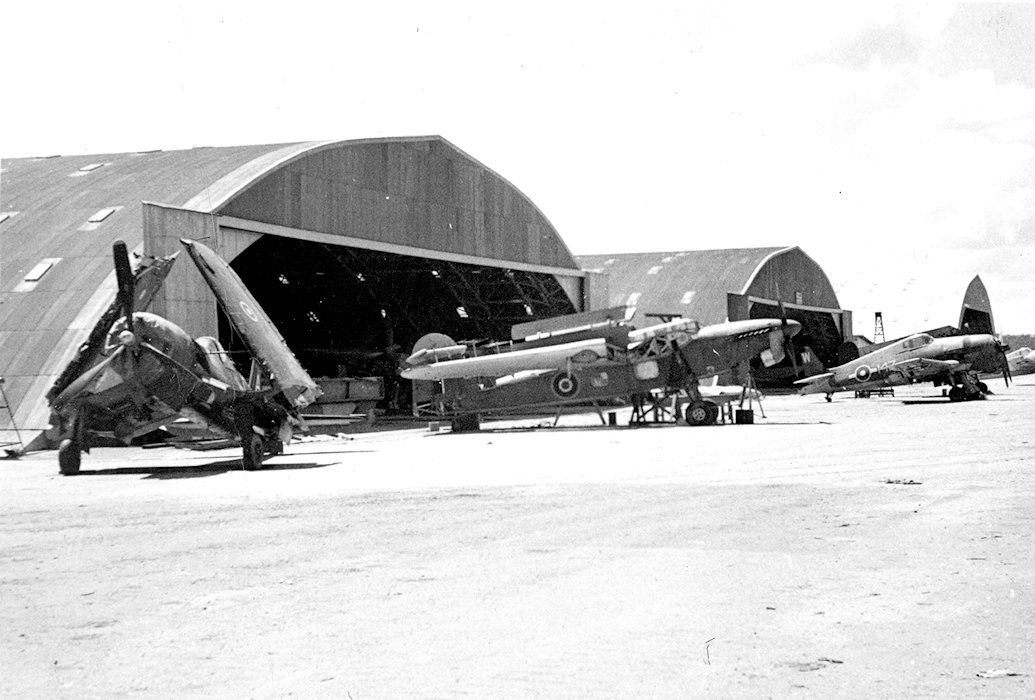
Kerry Road, Archerfield, the main technical site of TAMY 1 showing aircraft that have recently been assembled in the production hangars. These ‘Igloo’ hangars were the aircraft erection and modification site where ratings from TAMY 1, and later MONAB VII, were employed. From left to right the aircraft are, a Corsair, a Barracuda, and a Hellcat, a second Hellcat can be seen in the distance. Photo: From the collection of L.J. Jay, editor of the ship’s magazine ‘Nabsford News’.
April was the first month of operation for the Air Yard, the original monthly output target for TAMY I called for 15 major inspections, 25 minor inspections (and modifications), 25 aircraft erections, and 25 engine overhauls, together with component repair work arising from these tasks. The need to divert manpower to construction works meant that only 4 Corsairs were erected, 3 Expediters were erected by a civil firm at Archerfield with assistance from ratings from the Yard. The first of the newly erected Corsairs was test flown on April 16th.
Although the stores and equipment had arrived on station during early May the ‘Yard’ was still in no shape to meet targets. On May 9th HMS NABSFORD celebrated VE-Day (Victory in Europe was declared the day before), but the celebrations were brief and work resumed the following day. The programme for May was; erect 15 Seafire III & 35 Corsair IV, and perform Minor Inspections on 7 Corsair IV. Performance was well short of these targets with only 9 Seafires & 15 Corsairs being erected but all minor inspections were completed. This shortfall was due to a lack of workshop equipment coupled with spares shortages. In an attempt to improve output the 'stage' system of aircraft erection was introduced, necessitating a new layout in the erection hangar.
Despite the poor performance during April and May the required monthly output for TAMY I was to be increased for future months, rising from 25 to 75 erections, major and minor inspections however remaining at the same level. An additional new function was to be introduced from June, the reduction to spares and produce of category Z (beyond repair) aircraft sent back from the forward area. To facilitate this new task additional premises were acquired at the Benedict Stone Works in Rosetta Street, Fortitude Valley; formerly used by the US Navy Torpedo Overhaul Shop these premises were situated about 7 miles from Rocklea Camp, and fairly convenient for access to the wharves.
Seafire production shortfalls and off-site aircraft erection
In an effort to increase Seafire output additional aircraft assembly was to be untaken at R.A.A.F Oakey, Queensland; an initial detachment of three Petty Officers and twenty-one other ranks from TAMY I arrived there on May 18th. The technical problems that plagued TAMY 1 also caused delays in getting production started at Oakey and a shortfall in production targets. The first completed Seafire III (PR196) was not ready for dispatch to TAMY 1 at Archerfield until July 14th. The detachment was to operate at Oakey until late October, and supplemented with men from MONAB VII from early August.
June's programme called for 10 Seafire III & 40 Corsair IVs to be erected together with 5 Corsair II & 1 Corsair II TR for minor inspections. Performance figures were 0 Seafire III, 24 Corsair IVs erected, 5 Corsair II & 1 Corsair II TR inspected. No Seafires could be assembled due to there being none available for erection until late in the month. The Corsair IV figures were affected by 11 engine changes becoming necessary through sand-contamination, and also by a lack of electrical spares. The minor inspections required more work than normal, the Corsair II aircraft having suffered considerable corrosion before arriving at Archerfield. On the first of June 1845 squadron was reformed at Archerfield as a single seat fighter squadron issued with 24 Corsair IVs. The squadron was to move to the newly established MONAB VI at RNAS Maryborough on the 23rd.
Early June saw the completion of the stop butts at Archerfield undertaken by Yard resources. Later in the month three large stores were acquired at Runcorn, about 6 miles from Rocklea Camp and 4 from Kerry Road. These were to provide an airframe parts store, an engine store and a general store; this acquisition resulted in the building of a 20,000 sq. foot store at Kerry Road being cancelled. The transport and manpower problems encountered so far prompted a request to be sent to the admiralty to increase the complement of the Motor Transport component, and for an increase in the number of radio mechanics borne due to increasing commitments.
The first releases from Royal Naval service were made on June 18th under the 'Age and Service Scheme’; with the war in Europe over plans to demobilise ‘hostilities only’ personnel had been put into action though TAMY I was initially little affected by this. The unit was to suffer temporary manpower shortages from June 20th however, through the release of the first 100 men for long leave (10 days); Australian families offered hospitality and accommodation for RN personnel at various locations, from coastal towns to sheep ranches all across Queensland. TAMY I was visited by His Excellency the Governor of Queensland, Sir Leslie Wilson, later in the month, and an inspection tour of the various sites comprising the 'Air Yard' was made.
At the beginning of July 1945 Commander Rogers-Tillstone was promoted to the rank of Captain, and the Flag Officer Naval Air Pacific (FONAP), Rear Admiral Portal, visited the station on the 8th; Admiral's Divisions were held, and the Admiral addressed the ship's company, praising their efforts and predicting that TAMY I could expect to be on station for at least another year.
The production targets for July had TAMY I attempting to recover the shortfall in Seafire production. Targets were; erections - all available Seafire III - up to 25. & 25 Corsair IV, perform minor inspections on 15 Corsair II. Performance was 9 Seafire III (all erected at RAAF Oakey) & 25 Corsair IV erected with 11 Corsair II inspections, 1 Engine change and 1 Avenger (major Inspection). A further hold-up in the Seafire erection line occurred when a batch of crated airframes were received with unmatched mainplanes. Uncompleted Corsairs resulted from stores being unobtainable.
Early July saw the conversion of a building at Archerfield, acquired from the RAAF., into a Test Flight Office, and a Maintenance Test Flight was set up as a separate entity under the Senior Test pilot. The ground crew consisted of ratings who had by now gained valuable experience of test flying snags. The first Ship's Company Ball was held on July 28th at Brisbane City Hall, coincidentally this was the same time that the Labour party was clinching their victory in the UK general election.
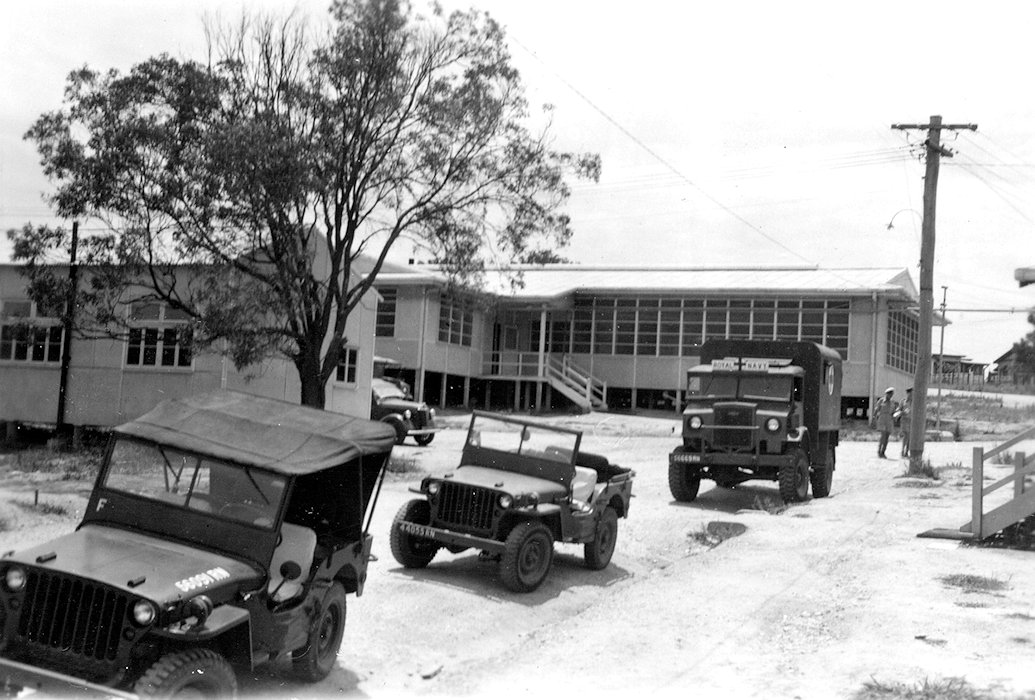
Rocklea camp, Brisbane: This view shows the administration buildings at RN Camp Rocklea. Note the ambulance parked behind the two Jeeps suggesting that the temporary sick bay is nearby. Photo: From the collection of of L.J. Jay, editor of the ship’s magazine ‘Nabsford News’.
August 1945 - Victory over Japan
August saw the introduction of the new Seafire Mk. XV to the inventory of TAMY I. this month's programme called for 20 Seafire III, 5 Seafire XV, & 40 Corsair IV to be erected, with 10 Corsair II & 5 Corsair II (T) for minor inspections. Performance figures were 9 Seafire III, 0 Seafire XV, 23 Corsair IVs erected, and 1 Corsair II & 1 Seafire inspected. Delays in Seafire production continued as in previous months, and Corsair output again suffered due to all Corsair IVs being required to be fitted with Gyro Grin Sights, which held tip Corsair production; this was followed up by S.I. / P & W 2800/1, (Special Instruction from Pratt & Whitley) which necessitated a considerable amount of work on each aircraft to get at the fuel control valve.
MONAB VII arrives: From August 10th the site at Archerfield was shared by MONAB VII, HMS NABREEKIE, this unit was outfitted as a Forward area Receipt & Despatch Unit but no operational location had been assigned prior to its arrival in Australia so it was decided to operate it alongside TAMY I at Archerfield until being called to the forward area. An additional 300 ratings started work at Kerry Road on August 10th; this resulted in some disruption while they were introduced to the stage system in use for aircraft erection. These additional ratings were integrated into the TAMY I gangs, and in some areas took over from them.
Victory over Japan (VJ) Day was announced on August the 15th and this was celebrated in Brisbane the following day (in Australia this was referred to as VP or Victory in the Pacific Day).
Work on engines was able to commence during September, none being possible during April to August apart from putting one or two engines through to test the lines and to practice the personnel concerned. Limited supplies of some outstanding spares became available in September enabling a few engines to be processed during the month. With the war against Japan now over, the numbers of replacement aircraft required for the BPF had reduced considerably, work shifted towards the stripping out of surplus aircraft and disposal of surplus airframes, engines and other equipment.
On October 15th the personnel and aircraft of 721 squadron disembarked from HMS UNICORN, having been evacuated from RNAS Ponam (MONAB IV) in the Admiralty Islands. The squadron, a Fleet Requirements Unit, was at Archerfield to re-equip before sailing to Hong Kong for operations with MONAB VIII at Kai Tak airport. The new equipment complement was to have been 12 Vengeance Target Tugs, 6 Defiant Target Tugs, 9 Corsairs, 6 Beaufighters, 6 Mosquitoes, 2 Avengers, and 1 Harvard. The twin engine Beaufighters and Mosquitoes were not issued however, the unit's tasking having been revised. The squadron was to remain at Archerfield for the next two months preparing and testing their new aircraft.
Re-organisation: On October 22nd Rear Admiral Portal flew into Archerfield and addressed the assembled ship's companies of TAMY I and MONAB VII at Kerry Road; he told the men that following a review of RN assets in the Pacific theatre TAMY I would be scaling down over the next few months but still had an important role to play, announcing that the newly arrived MONAB VII would be paying off in early November to leave a much smaller 'Air Yard' to continue the repair and maintenance tasks which still existed. A week later the first 500 men from HMS NABSFORD were embarked on the Troopship STRATHENDEN for passage home to the UK. The RN detachment left RAAF Oakey to return to Brisbane on October 26th
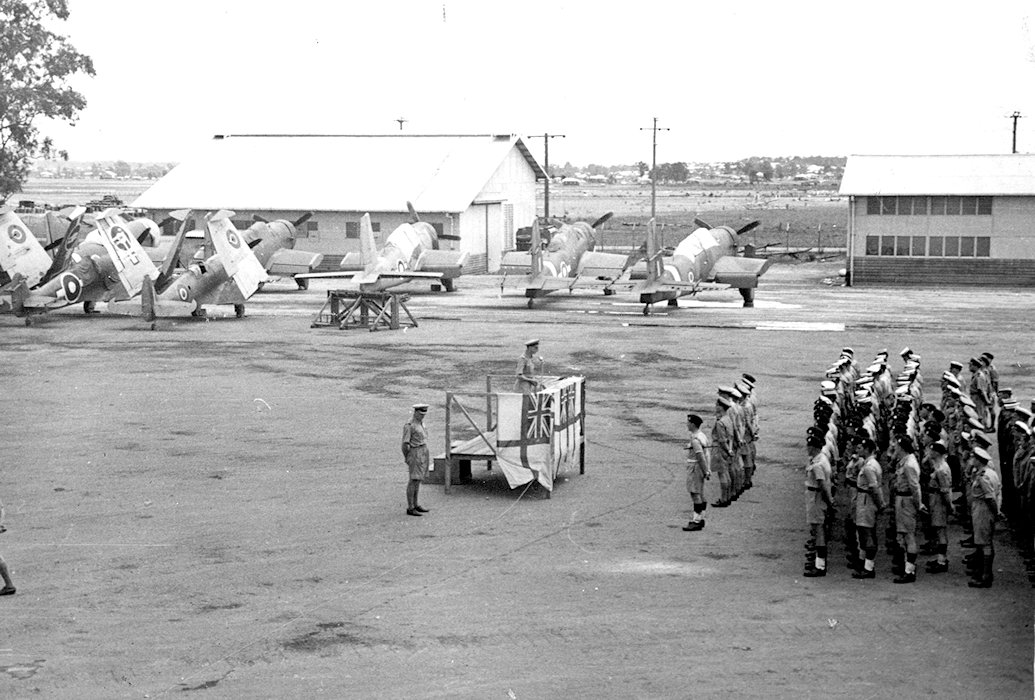
Kerry Road, on Monday, 22nd October, 1945: Rear-Admiral R. H. Portal, D.S.C., R.N., Flag Officer Naval Air Pacific, addresses the assembled Officers and Ship's Companies of TAMY I and MONAB VII. He outlined the future -programme for both unit’s during the ensuing months. Seafires and Vultee Vengeance target tugs are lined up in the background. Photo : From the collection of L.J. Jay editor, Nabsford News magazine.
The four Sea Otters of 1701 ' A' flight arrived from RNAS Maryborough on November 1st to prepare for embarkation in the escort carrier STRIKER on the 4th; this unit was also bound for MONAB VIII at Kai Tak airport.
MONAB VII Paid Off: HMS NABREEKIE was paid off on November 5th; many of the unit's technical ratings being absorbed into HMS NABSFORD, many of these formed Mobile Repair Unit 3 (MR3), others were drafted to HMS GOLDEN HIND, RN barracks, Sydney, to await other postings.
Ship’s newspaper launch: The members of the ship's company saw the launch of their own newspaper, the 'Nabsford News' during November, prior to this a newsletter 'Nabsford Times' was posted on the ship's notice boards for communal consumption. The 'Nabsford News' was a commercially printed fortnightly newspaper of eight pages; it was sold for one penny and eight editions were produced before the ship paid off. 721 squadron embarked in the escort carrier SPEAKER on December 28th, this was to be the last Fleet Air Arm flying unit to operate from Archerfield.
Christmas 1945 saw TAMY I's own Concert Party put on its one and only public performances at Anzac House in Brisbane on December 27th & 29th, the production entitled "Tamy Trifles" was well received. Performances were compeered by S/Lt. Langford and comprised of a variety of acts from singing to cutlass and club swinging performed by Master at Arms Barnes. The concert party had been regularly putting on shows for other military units in the area but this was to be their only show for a civilian audience.
January1946 the rundown to closure
At 12:45 on January 18th 1946 'Clear Lower Deck' was piped, the Captain addressed the ship's company and informed them of the future programme for TAMY I. Mid-February would see the ship's complement reduced by two thirds, approximately 1000 men being drafted either home or to RN Barracks , Sydney; HMS NABSFORD was to pay off on March 31st 1946 and the 'Air Yard' closed, one year and four days after the main body of TAMY I arrived at Archerfield. The remaining ships company of around 500 would de-store ship and prepare the various sites for handover to local authorities, further men would be sent home during the run down to closure if they qualified under the age and service scheme.
HMS NABSFORD & RN Air Maintenance Yard Archerfield paid off March 31st 1946; the various sites comprising the 'Air Yard' were returned to the Australian authorities.
HMS 'NABSFORD'
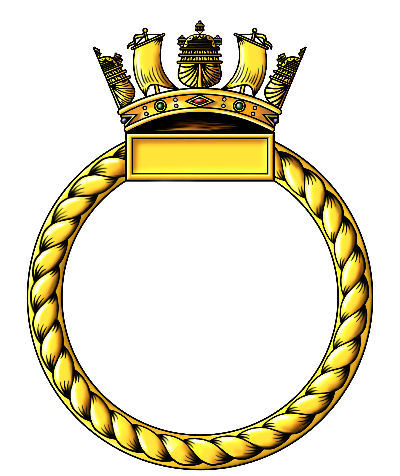
Function
Aircraft Maintenance Yard
Aviation support Components
Self-contained 'Air Yard', with Mobile Repair 3 and Maintenance, Storage & Resave Units 7 & 8 added in Australia.
Aircraft type supported
Avenger Mk. I & II
Barracuda Mk. II
Corsair Mk. II & IV
Expeditor II
Firefly I
Hellcat Mk. I & II
Martinet TT. I
Reliant I
Seafire III & L.III
Sea Otter I
Tiger Moth I
Vengeance TT. IV
Commanding Officers
Commander B. J. L. Rogers-Tillstone 01 February 1945 to 31 March 1946 [Promoted Captain 01 July 1945]
Related items
R.N.A.M.Y. Archerfield History of the airfield and other information - part of the Fleet Air Arm Bases web site
Nabsford News copies of 7 out of the 8 editions of the HMS NABSFORD ship's magazine avail to be read
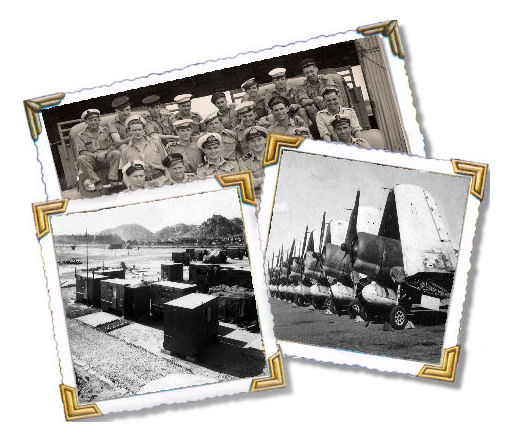
Comments (0)